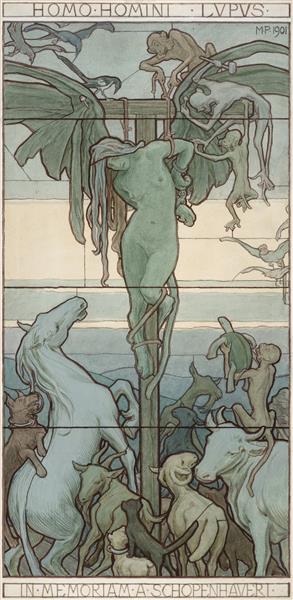Description
The work "Homo homini lupus" of 1901, painted by Maximilian Pirner, is a fascinating example of its mastery in the use of watercolor, a medium that dominated with a distinctive and evocative approach. This piece represents a meditation on human nature, encapsulating its complexity and often its brutality, through a work that is not only visually shocking, but also conceptually rich.
In the composition, Pirner presents an intrinsic duality between the human and the bestial. The title of the work translates approximately as "man is a wolf for man", a phrase that is attributed to Plauto and has resonated throughout history in discussions about the aggressive and competitive nature of humanity. This work seems to accentuate this dilemma through its choice of colors and shapes. The dark and gloomy tones predominate, creating an atmosphere that suggests both tension and hostility. The faces and bodies of the characters, whose features are indistinct and almost hybrid, hint a disturbing similarity between men and wolves. This ambiguity in the human figure reinforces the idea that, in a context of survival, the lines that divide the civilized and the wild are blurred.
The watercolor technique used by Pirner is remarkable for its fluidity and transparency, characteristics that provide a sense of movement and life to work. The effects of light and shadow are handled with great skill, which gives depth to the image and enhances the underlying emotional tension. The background, although not detailed, envelops the characters in an environment that reflects the conflictive dynamics between them, suggesting a scenario that can be both urban and natural.
The characters that emerge in the painting are enigmatic. Although the work does not focus on a specific number of figures, its disposition and Pose suggest a confrontation. The intense and almost threatening look in his personal expressions suggests a narrative of primary power, challenge and instinct. These elements make "Homo homini lupus" a work that invites reflection on the essential duality of humanity, its ability to create and destroy, to collaborate and to betray.
Maximilian Pirner, originally from Bohemia, had an artistic career marked by his commitment to symbolism and avant -garde art of his time. His work often explores the limits of human psychology, as well as the interactions between man and the universe, being "Homo Homini lupus" a clear example of his exploration of human nature. This type of representation was common in symbolism, movement of which Pirner was part, which often resorted to issues of morality and existentialism.
Through its aesthetic characteristics and the philosophical load that displays, "Homo homini lupus" remains relevant, resonating with the viewer in a world where the problems of violence and the struggle for power continue. This work not only serves as an artistic statement, but also stands as a critical comment on the human condition, an issue that will continue to be explored by future generations.
In conclusion, "Homo Homini lupus" is a testimony of the genius of Maximilian Pirner and his ability to capture the complexity of humanity through watercolor. This work does not simply invite an aesthetic observation, but to a deep reflection on human nature and its most basic instincts, thus undermining the borders between art and life itself.
KUADROS ©, a famous paint on your wall.
Hand-made oil painting reproductions, with the quality of professional artists and the distinctive seal of KUADROS ©.
Art reproduction service with satisfaction guarantee. If you are not completely satisfied with the replica of your painting, we refund your money 100%.

